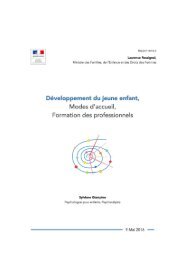agrl_innovations_in_ssa.pdf?utm_content=buffercb41d&utm_medium=social&utm_source=twitter
agrl_innovations_in_ssa.pdf?utm_content=buffercb41d&utm_medium=social&utm_source=twitter
agrl_innovations_in_ssa.pdf?utm_content=buffercb41d&utm_medium=social&utm_source=twitter
You also want an ePaper? Increase the reach of your titles
YUMPU automatically turns print PDFs into web optimized ePapers that Google loves.
(BCPA), an association represent<strong>in</strong>g and promot<strong>in</strong>g cattle producers’ economic <strong>in</strong>terests.<br />
The paper proposed policy alternatives for revitalis<strong>in</strong>g the cattle <strong>in</strong>dustry by improv<strong>in</strong>g cattle<br />
prices, provid<strong>in</strong>g <strong>in</strong>centives for <strong>in</strong>tensify<strong>in</strong>g cattle production and <strong>in</strong>creas<strong>in</strong>g the national cattle<br />
off-take. This resulted <strong>in</strong> broad debate and allowed policymakers to consider the policy options<br />
that could improve the efficiency of the sector.<br />
Interventions and stakeholder roles. Key stakeholders <strong>in</strong> the livestock sector are: the<br />
M<strong>in</strong>istry of Agriculture (MoA), responsible for policy regulation and through its extension and<br />
veter<strong>in</strong>ary services, livestock management, health and disease control, the BMC and 60,000<br />
cattle producers represented, s<strong>in</strong>ce 2006, by the BCPA, and prior to this a number of regional<br />
associations. Stakeholder deliberations on the BCPA policy paper resulted <strong>in</strong> Government<br />
and the BMC accept<strong>in</strong>g export-parity pric<strong>in</strong>g and support to convert from the market<strong>in</strong>g of<br />
older cattle to long-weaner and feedlot production systems. At the same time Government<br />
negotiated successfully for tariff free entry of livestock products to EU markets. These moves<br />
greatly expanded the demand for cattle, although supply rema<strong>in</strong>ed a problem. Consequently,<br />
the BMC agreed a new strategy, which is now be<strong>in</strong>g implemented. The strategy <strong>in</strong>cludes: a<br />
restructur<strong>in</strong>g of operations to reduce BMC’s cost base, improv<strong>in</strong>g throughput, and process<strong>in</strong>g<br />
efficiencies aimed at deliver<strong>in</strong>g the best prices for BMC products at least cost and to ensure<br />
BMC’s long-term susta<strong>in</strong>ability. Restructur<strong>in</strong>g <strong>in</strong>volves the direct purchase of cattle from<br />
producers, with a focus on younger cattle, which are then fattened for 90 days <strong>in</strong> contractorowned<br />
feedlots prior to slaughter (BMC, 2009).<br />
Achievements. Stakeholder <strong>in</strong>teractions have resulted <strong>in</strong>:<br />
• An <strong>in</strong>crease <strong>in</strong> cattle prices, which has <strong>in</strong> turn led to <strong>in</strong>creased herd take-off, <strong>in</strong>creased<br />
<strong>in</strong>comes for farmers and an <strong>in</strong>crease <strong>in</strong> land values. With 90 percent of cattle be<strong>in</strong>g<br />
sourced from smallholder farmers this is play<strong>in</strong>g an important role <strong>in</strong> poverty alleviation<br />
• A record throughput of cattle be<strong>in</strong>g slaughtered <strong>in</strong> 2010 with abattoir use now approach<strong>in</strong>g<br />
capacity<br />
• The national herd demographic becom<strong>in</strong>g younger, as farmers realise they are able to<br />
<strong>in</strong>crease their profits by sell<strong>in</strong>g younger animals.<br />
At the same time opportunities are now occurr<strong>in</strong>g to build on these successes by the application<br />
of new research knowledge – the full extent of which is yet to occur. Innovative products,<br />
<strong>in</strong>clud<strong>in</strong>g formulated cattle feed mixed us<strong>in</strong>g efficient livestock feed mixers are be<strong>in</strong>g adopted,<br />
as is eco-friendly pest control for flies.<br />
Emerg<strong>in</strong>g or unresolved challenges. Research has an important and ongo<strong>in</strong>g role <strong>in</strong> improv<strong>in</strong>g<br />
cattle management, health and disease control and ensur<strong>in</strong>g the most cost-efficient livestock<br />
feed<strong>in</strong>g regimes are used <strong>in</strong> l<strong>in</strong>e with animal welfare, environmental and human health<br />
protection.<br />
Lessons learned. Understand<strong>in</strong>g the role the private sector plays <strong>in</strong> facilitat<strong>in</strong>g change at<br />
local, regional, and national government levels is important when consider<strong>in</strong>g changes to the<br />
enabl<strong>in</strong>g environment for value cha<strong>in</strong>s. It is essential that the private sector is able to speak<br />
with an <strong>in</strong>formed and unified voice and is able to engage with Government.<br />
The case studies: Southern Africa 45






